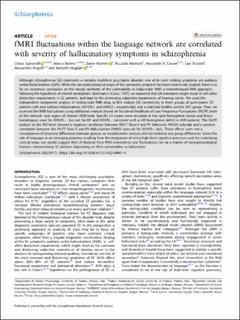| dc.description.abstract | Although schizophrenia (SZ) represents a complex multiform psychiatric disorder, one of its most striking symptoms are auditory verbal hallucinations (AVH). While the neurophysiological origin of this pervasive symptom has been extensively studied, there is so far no consensus conclusion on the neural correlates of the vulnerability to hallucinate. With a network-based fMRI approach, following the hypothesis of altered hemispheric dominance (Crow, 1997), we expected that LN alterations might result in self-other distinction impairments in SZ patients, and lead to the distressing subjective experiences of hearing voices. We used the independent component analysis of resting-state fMRI data, to first analyze LN connectivity in three groups of participants: SZ patients with and without hallucinations (AVH/D+ and AVH/D–, respectively), and a matched healthy control (HC) group. Then, we assessed the fMRI fluctuations using additional analyses based on fractional Amplitude of Low Frequency-Fluctuations (fALFF), both at the network- and region of interest (ROI)-level. Specific LN nodes were recruited in the right hemisphere (insula and Broca homologous area) for AVH/D+ , but not for HC and AVH/D–, consistent with a left hemisphere deficit in AVH patients. The fALFF analysis at the ROI level showed a negative correlation between fALFF Slow-4 and P1 Delusions PANSS subscale and a positive correlation between the fALFF Slow-5 and P3 Hallucination PANSS subscale for AVH/D+ only. These effects were not a consequence of structural differences between groups, as morphometric analysis did not evidence any group differences. Given the role of language as an emerging property resulting from the integration of many high-level cognitive processes and the underlying cortical areas, our results suggest that LN features from fMRI connectivity and fluctuations can be a marker of neurophysiological features characterizing SZ patients depending on their vulnerability to hallucinate. | en_US |

